Do you plan to travel with your ferret?
What do you need for a road trip?
Today I will share with you tips and advice about traveling with a ferret. That is not an impossible task, but it is a good idea to organize the entire trip a day or two before the real deal. So, what do you need for it, where can you go, and how to prepare your ferret for it you can read right here!
TABLE OF CONTENTS
Can Your Ferret Travel In A Car?
Yes, ferrets can travel with you in a car just like with any other pet. Most ferrets don’t mind traveling, but that doesn’t mean you can simply place a ferret in transportation and put it in the car. There are a few things you can do to make the road trip more comfortable for you, your family, and your ferret.

What To Do Before Going On A Road Trip?
There are a few steps you can take before traveling that will keep you relaxed during the entire road trip. Those steps are connected to the ferret, the equipment you need, and the papers you have to gather for a safe and stress-free adventure.
Visit The Vet With Your Ferret
First thing first, make sure your ferret is healthy. Observe your ferret and make sure he acts like before, with the same energy level, with a good poop, and a healthy appetite. Ferrets can get sick and you don’t want to experience that in a different city or even country.

It is a good idea to visit the vet and get official proof that you have a healthy ferret. While you are at the vet, you can ask for a ferret flea medicine that will protect your ferret from nasty fleas and other pests.
Gather The Necessary Documentation
If you are going out of state, make sure you have all the vaccination in check. Most pets, including ferrets, aren’t allowed to cross the border without rabies vaccination so make sure you have one. Also, if your ferret has a microchip, bring those papers too. Everything related to your ferret and his registration at your veterinarian should come with you on every road trip you and your ferret take.
Make Sure Ferrets Are Legal On Your Destination
Ferrets are considered exotic pets which means there are cities and states that don’t allow them. It doesn’t matter whether you are traveling through the country or you are staying there, you have to check the ferret legality issue before going on a trip.

A good place to start with it is my post about Ferret legal states and after that, read the laws and regulations of each country you are visiting.
Prepare The Ferret First Aid Kit
A ferret first aid kit is a box with medicine and other equipment that can help you take care of a sick or injured ferret. That box can also have emergency contact numbers and it is a very smart move to put it in the car with you. If you don’t have the first aid kit, you can easily make one. The list of items you can put inside find in my post about Making your own ferret first aid kit.
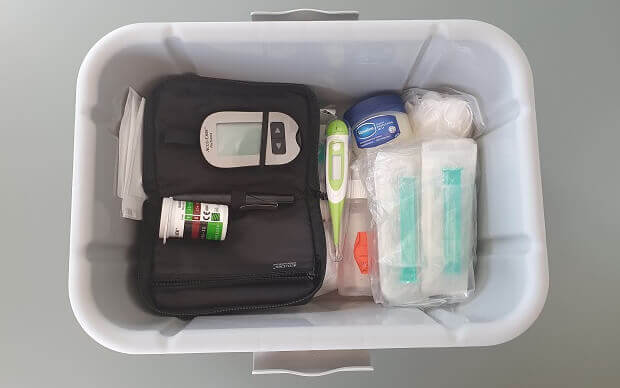
If your ferret needs to take some medications, make sure you bring them with you. You can’t risk rushing to the unknown veterinarian in an unknown town simply because you didn’t think your ferret will need the medicine.
Equipment For Ferret Travel
Besides a checkup and papers, you will need to prepare other ferret equipment too. You have to find something to put your ferret in, something for him to eat and drink, and many other small items. Let’s check them out and start from the biggest.
Ferret Travel Cage
The most important accessory is the travel cage. It is important for it to be big enough for a ferret to be comfortable in. I recommend travel cages made of plastic with side doors made of metal. Those doors have a grid so your ferret will have fresh air and he will see what is going on around him. Another one I would recommend comes with doors on top of the cage, also made of plastic. Plastic is good because it is easy to clean and it is budget-friendly.
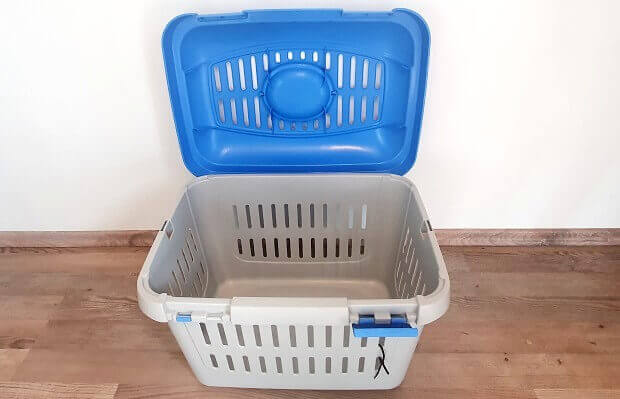
What I wouldn’t recommend (especially for long trips) is a ferret backpack or a ferret carry bag. Both of them are mostly made of fabric so your ferret will probably make a mess inside (with food or poop and pee). If they are plastic, then your ferret will be very hot inside. Also, they tend to be on the smaller side which means that your ferret won’t feel comfortable after a certain amount of time.
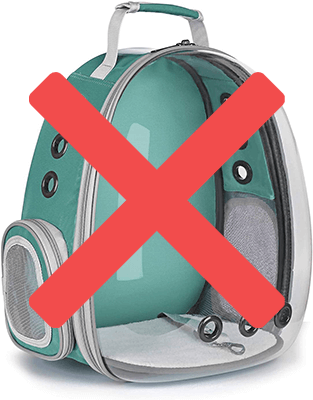
If you have more than one ferret, it is a good idea to check dogs’ travel carriers. They are similar in design, but much bigger so your ferrets won’t feel crowded. But, make sure the grid on the doors is small enough so your ferret can’t escape between the holes.
Fill It With Ferret Hammocks
If you want to make your ferret comfortable, you have to fill the travel cage with hammocks. Most travel cages come with holes on each side so you can easily attach the ferret hammock and let it hang. Use only hammocks (not blankets) so your ferret won’t make them dirty.

Hammocks are elevated from the bottom and away from the mess your ferret can make inside. Also, it is far more comfortable to hang in the air than sleep on the bottom of the travel cage.
Prepare Food And Water Bowls
If you are going on a short trip (under an hour) then you don’t have to prepare food and water bowls, but make sure you have food and water with you in the car. It is better to be safe than sorry. If you are going on a long trip, attach both food and water bowls on one side of the travel cage.
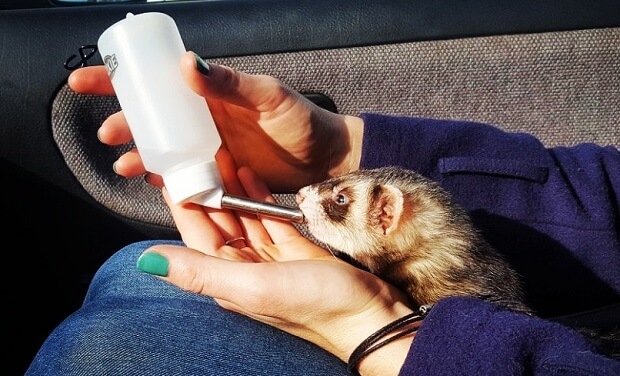
If you aren’t sure which bowls to use, read my post about food and water bowls that can help you with the decision. I usually don’t recommend water bottles because it hurts ferret’s teeth, but if you are going on a trip once or twice a year, a good quality water bottle is OK, especially because it could make less mess in the transporter.
Bring Your Own Food And Water
If you are going somewhere, bring your ferret’s food with you. You don’t have to bring everything, but make sure your ferret has enough food for the entire time you are there. That way you won’t have to go around looking for that food brand and panicking if you can’t find it in any store.

Ok, you don’t have to bring the water for the entire vacation, but you have to bring water for the road trip. You never know what might happen during travel and having water with you is smart for you, your family, and your pet.
Bring The Litter Box
Ferrets poop often and this is another crucial part of the ferret travel equipment. Yoda is one of those ferrets that will poop inside the transporter roughly 10 minutes after I’ve put him inside. That is why I have to have a litter box in the transporter no matter how long (or short) my road trip will be.
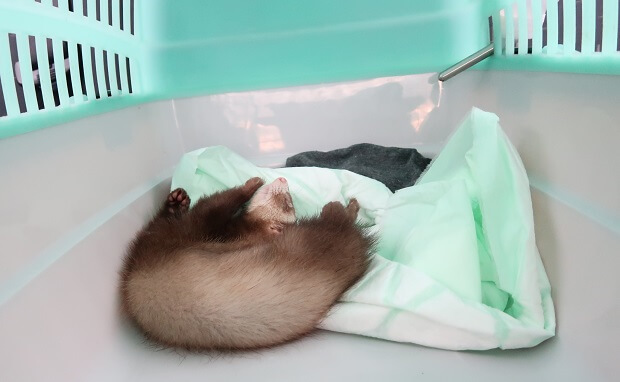
Put the litter box all the way to the back of the transporter. Use the same holes in the transporter you used to attach the hammock and fix the litter box because your ferret will try to knock it over. Why? Because that is what ferrets do. That is the same reason why I don’t recommend puppy pads in the transporter. Ferrets will probably tuck it away or sleep on it and end up pooping or peeing on the floor.
Don’t Forget Harness And Leash
Going on a road trip means exploring and you know your ferret can’t wait for that. So, make sure you pack a harness and a leash so you can let your ferret explore the destination once you come there. The same story is with breaks during the trip. You need to stretch your legs so you can be sure your ferret needs it too.

Although having a harness and a leash is a very smart move, don’t put the harness on your ferret when he is in the travel cage. Once you take your ferret out of the cage, place the harness and leash on him and let him sniff the surroundings.
Traveling During Extreme Temperatures
It is not the same if you are traveling in the spring and autumn or during summer and winter. More extreme temperatures in summer and winter require a few steps more in your preparation. Average temperatures during spring and autumn won’t affect your ferret, but those during summer and winter can.
Traveling During Summer
Summer is the hottest season and although we love the heat, ferrets don’t. Ferrets are prone to heat strokes and every temperature above 26°C (85°F) is too hot for them. You can travel with your ferret during summer, just make sure you can cool him down.
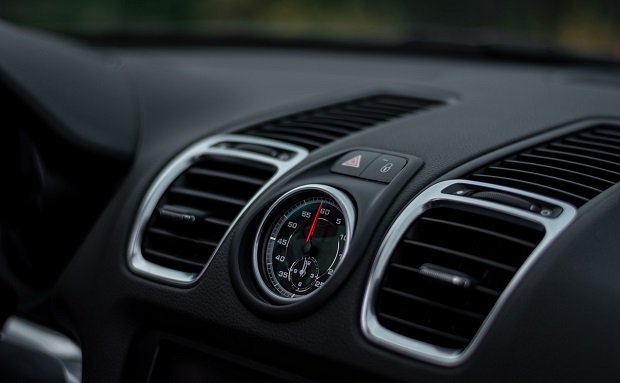
Don’t be afraid to use air conditioning in your car, just don’t point it directly at your ferret. You can also cool your ferret with wet towels and a frozen water bottle you’ve put in the travel cage. Also, make sure you know how to recognize the signs of a ferret heatstroke so you can react in time if it happens.
Traveling During Winter
Traveling during winter is much less complicated than traveling during summer. Ferrets handle the cold much better than heat. But, that doesn’t mean you can leave it in a cold car while you go warm up. Bring your ferret with you.

I know that driving in a warm car is great, but make sure you don’t bring the temperature too high. Also, don’t put too many layers in the travel cage to keep your ferret warm. If you overdo it, you can give your ferret heat stroke, just like during high summer temperatures.
Conclusion
Ferrets are OK travel companions, as long as you give them everything they need. If a trip is long, make sure your ferret has enough food and water. Take breaks so you (and your ferret) can stretch legs. A car is the best way to travel with a ferret because you can stop if needed whenever you like. Did you travel with your ferret? How did your ferret handle the trip? Share your experiences with us in the comments below and subscribe to the Friendly Ferret Newsletter!





















Leave a Reply